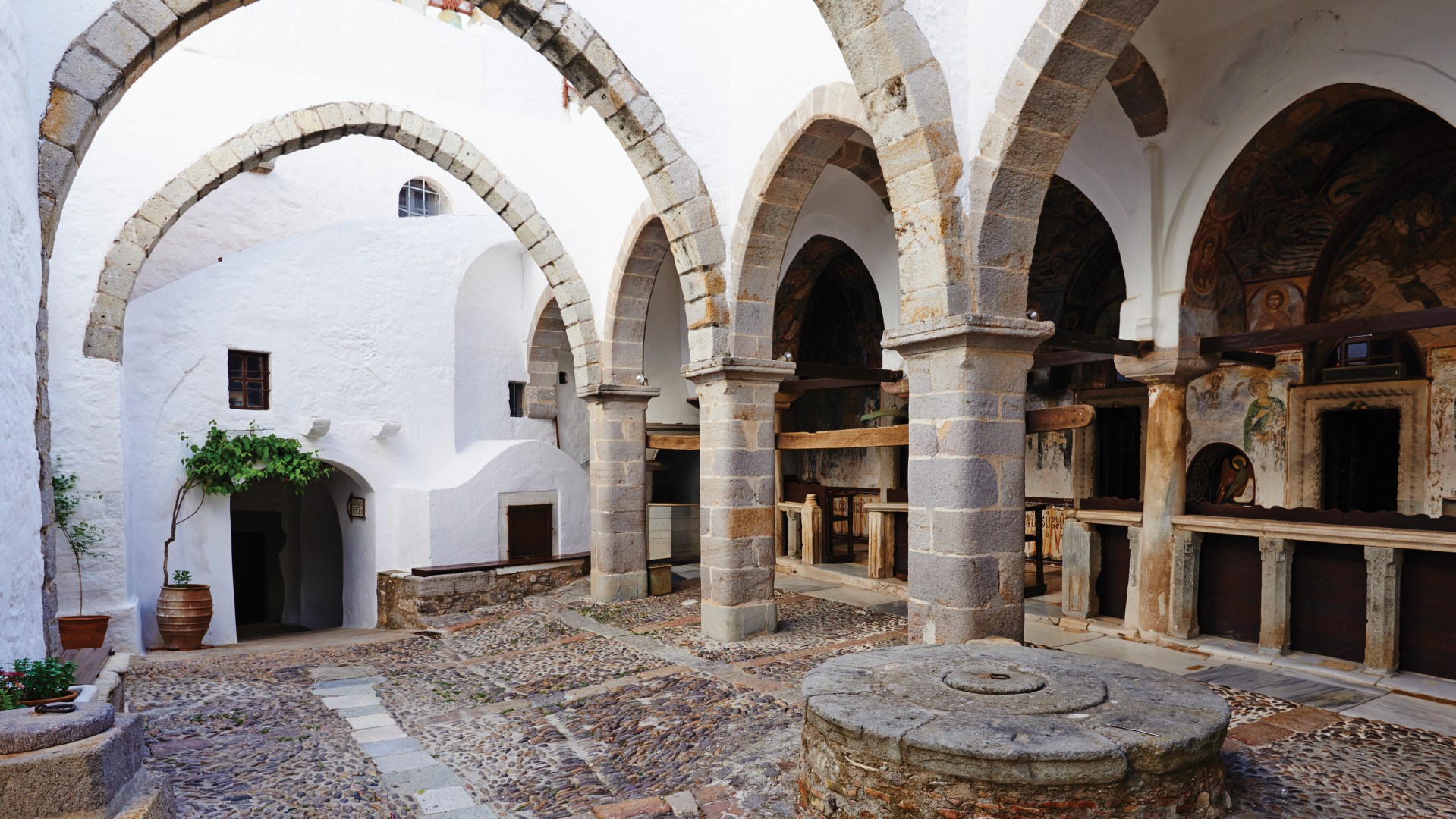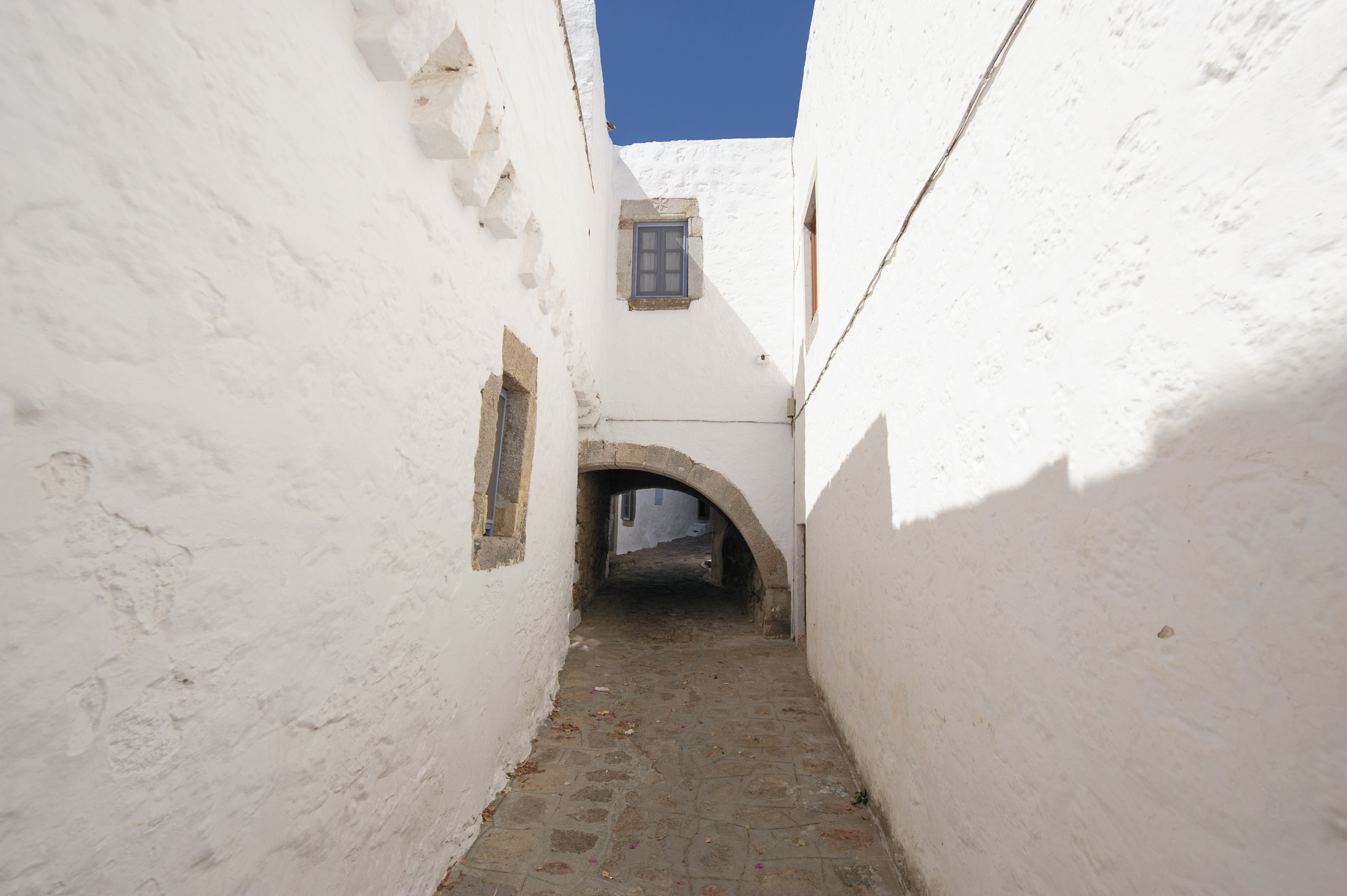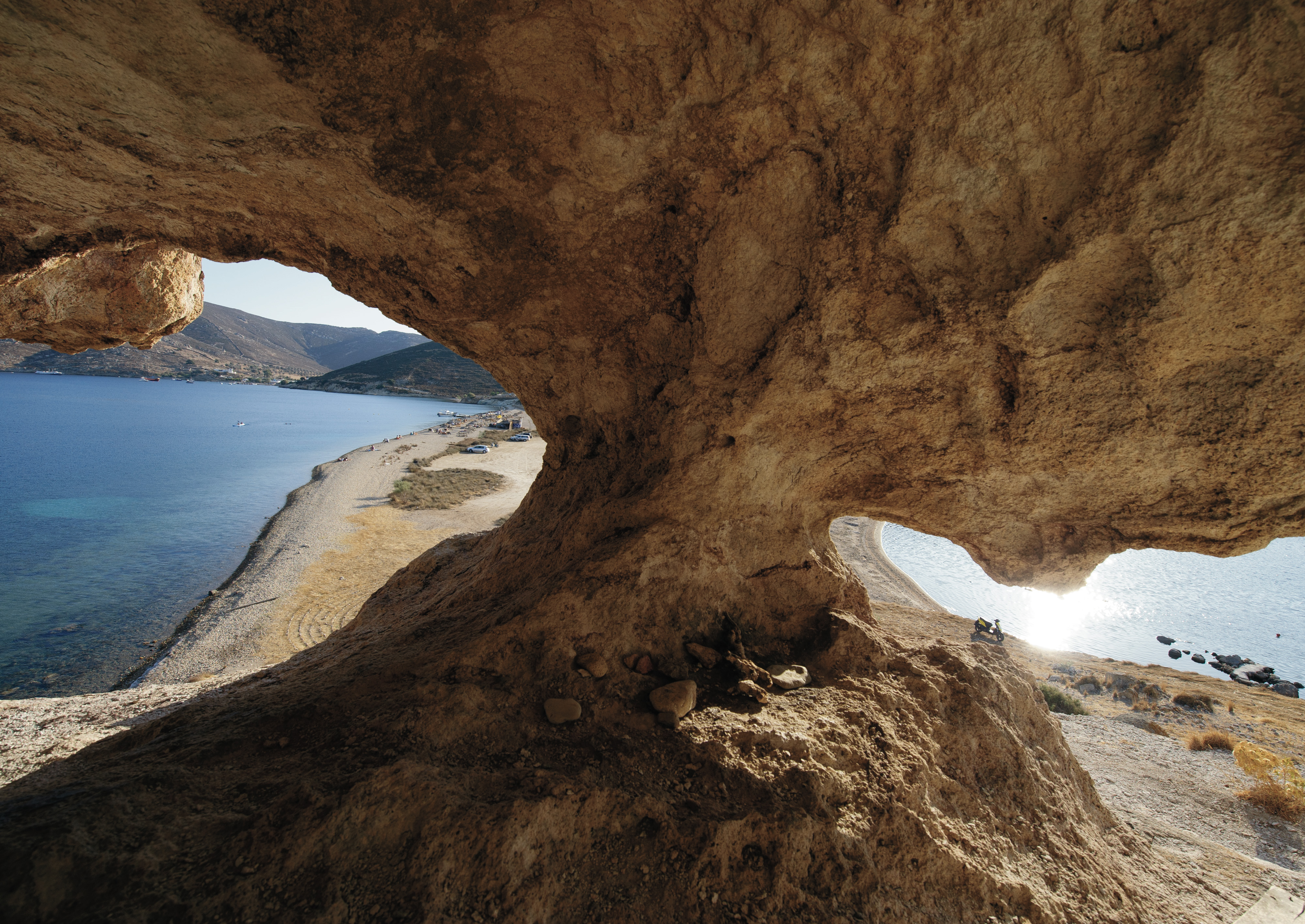I was on the island called Patmos. To be precise, I was in the Orthodox Monastery of Saint John the Theologian, on a fortified hilltop once occupied by a temple to Artemis, a short walk from the cave where the author of the Apocalypse is said to have received the revelation of the end of time. And I was about to receive a small revelation of my own.
Behind me, the whitewashed surfaces of a stone-paved courtyard resonated with the sounds of an overheated summer afternoon. This had been a site of pilgrimage for a thousand years; I was a latecomer. Like others around me, I was more tourist than pilgrim. But for a moment I had stepped aside, between the pillars of a shaded portico, into an arcaded exonarthex, through a narrow doorway, and into a low vestibule. In front of me I caught a glimpse of a further opening that led into the monastery church itself. Its interior was dark, its surfaces layered in dense iconographic splendor.
But the church was closed. A rope was strung across the opening.
Conscious that this was the very heart of the monastery, I leaned in through the doorway, turning my head toward the light that filtered down from the vaulting above. One ear was turned back toward the sounds still shrilling from the courtyard outside. But the other half of my body had entered a different place entirely. In that instant, I was simultaneously aware of two very different relationships to space.
One was noisy, distracted, and disoriented—unfamiliar with the monastery’s labyrinthine plan, distrustful of its uneven thresholds, struggling to distinguish between 11th-century catholikon and 12th-century parekklesia. Even here it was alert to persistent push notifications—the sounds, perhaps mere vibrations, that tie us to many other spaces through virtual networks that are necessarily commercial in their ends and rarely devoted to the glory of God. That disposition had followed me into the courtyard and still echoed in one ear.
The other obeyed a different economy entirely. It was marked by a resonant silence—the silence of listening, of expectation, of making time and clearing space for an encounter with God. In that liminal moment, one thing was clear: We need such places. But for most of us, they are hard to find. Our culture is not good at building silence.
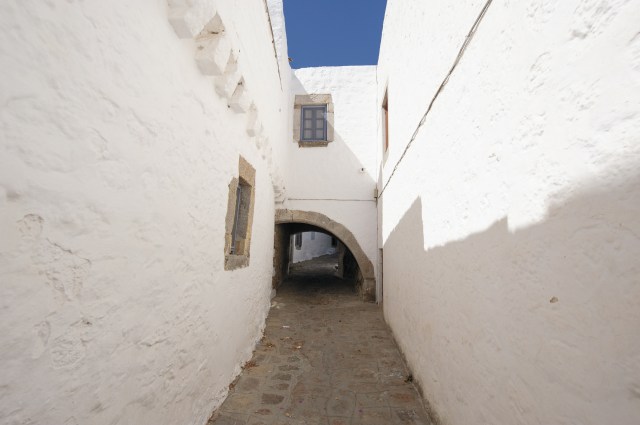 Massimiliano Cremascoli
Massimiliano CremascoliSilence is often associated with monastic vows. In the monastery, with its strict schedule and constrained setting, time and space conspire to nurture the possibility of quietness. That quietness is spiritual, yes, but also literal. What separates the silence from the noise on Patmos is, among other things, a thick wall.
The site of this monastery was chosen precisely for its proximity to the place where John heard from God. But John, we are told, was not here by his own choice. God put him in a place where he could listen: a small, barren island removed from the noise and the networks of the mainland—an island infamous as a place of exile. According to long-standing tradition, the revelation was given in a cave: a place of intensified silence, enclosed by walls of solid stone.
Like the cave, the monastery on Patmos is a place of palpable thickness. And that thickness is both material and immaterial.
In figurative terms, the thickness is a product of centuries of accumulated meaning and generations of careful stewardship. This architecture is not merely a fungible resource; it is not just a capital investment, nor for that matter a consumable. Founded in the 11th century, the monastery is a place where change has come slowly. One thousand years into its history, it awaits the moment that will end all time. And it stands in silent rebuke of our own, thinner, spaces. Once you have felt the thickness of such a place, even the most elegantly designed modern structures feel insubstantial.
But the thickness is also material. The Monastery of Saint John—like the tumble of smaller houses clustered around it—was built of stone. If you scan the island’s volcanic landscape, it becomes clear that this material did not travel far from quarry to building site. The monastery, we might say, is built of the same stuff as the cave. Its stonework is simple: blocks shaped by hand and fitted one on top of another. Its substance is undeniably solid and has served its purpose reasonably well for the past thousand years. Exceeding the demands of structural integrity, the walls are literally thick.
That thickness, which once served defensive purposes, today defends against intrusions of other kinds. Its sheer mass not only absorbs fluctuations in temperature; it also dampens the noisiness of the world beyond, making possible a peculiar kind of silence: the silence of a cave, the silence that allowed John to hear from God.
That same thickness does not, conversely, lend itself to other kinds of reception. The cell signal is poor, the Wi-Fi spotty. And such a structure does not readily allow for vast openings. It naturally generates a sense of enclosure, an inwardness that seems appropriate to the monastic life.
 Massimiliano Cremascoli
Massimiliano CremascoliMost of us do not inhabit such places. Our world is noisy, and we have never taken formal vows of silence.
We too must clear space to listen. After all, for the Christian, listening is hardly optional. The Creator endowed humanity with only one mouth but with two ears. We should, we are told, be quick to listen and slow to speak (James 1:19). To know the voice of the Shepherd is the great privilege of those who follow Christ (John 10:27). Blessed are those who hear (Rev. 1:3).
To listen well, we need quietness. That quietness is biblical—the restfulness of Sabbath, the stillness of knowing God, the solitude of the wilderness, or the space of prayer in a quiet room with a closed door. That closed door is not only a metaphor; it belongs in the same category as the thick wall, the cave, and the place of exile. These are real things, real places. For us, as for the author of Revelation, hearing God proves inextricable from bodily experience. Our lives are entanglements of the physical with the metaphysical.
So, quiet places are critical. Even in the most literal sense, sound is tied to space. Our ability to listen in stereo allows us to hear in three dimensions. We instinctively turn our heads to locate sounds, to experience the depth of specific places. And we can choose where to direct our attention. We can turn away from, or toward, a particular voice. We can choose to listen.
But some places are more conducive to listening than others. Our world is getting noisier, and finding quietness is more difficult than it used to be. Surviving pockets of silence have risen in value as they have become rarer, just as dark-sky landscapes have become more precious in an urban age.
In other ways, too, we may need to work harder to achieve a quietness that is receptive to the voice of God. Our culture bombards us with competing media, not least the voices of advertising, politics, and entertainment—the lines between them increasingly blurred, the intensity of their signals stronger than ever.
Increasingly, even our churches are not only places to hear from God but also envelopes for producing virtual content that must compete for attention with other messages—beholden not to the rhythms of the liturgical calendar but to the relentless beat of online rankings, license renewals, and software updates.
And our buildings are shaped by concerns that are profoundly restless. They share in the characteristic ethos of modernity—which, to quote the philosopher Karsten Harries, “stands in no essential relationship to the environment in which it happens to be located.” To be tied too deeply to a singular location becomes a liability, and mobility an asset. Outside of monasteries, it is vanishingly rare to encounter a lifelong commitment to a singular place. Even our electronics are mobile. And their signals follow us as we move around the world.
So, more than ever, Christians need places of stillness—places of periodic exile from a dominant culture’s networks of influence. We need them even if that exile is self-imposed. This is not in expectation of a latter-day revelation but rather to allow us to pay attention to the revelation that has already been given—to allow us to hear.
Silence also can be a gift to others. If our contemporary culture consumes vast quantities of space, place is in shorter supply, and places of quietness even more so. We live—more palpably than ever before—in a demonstrably restless world: one that longs, in its moments of clarity, for spiritual quietness. If we are to take seriously Augustine’s claim that our hearts are restless until they rest in God, then it follows that the proclamation of the gospel must find its counterpart in the clearing of spaces and the making of places that nurture the peculiar silence of listening. And not just listening, but listening to the voice of God.
Where noise and distraction are the rule and stillness the exception, sustained silence can be transformative—provoking questions that demand answers and prompt a reckoning with our very existence within the larger expanse of time and space. Not for nothing are the nations given the great injunction of Psalm 46:10: “Be still, and know that I am God.”
Yet it is hard to make room for stillness. And it is difficult to build structures of the sort of quiet integrity that informs the monastery of Patmos. Our built environment follows a different logic—one that resists thickness and conspires against attentiveness.
This is true in a literal sense. As a culture, we have moved away from thick construction. We build walls of thin layers separated by insulating air gaps; we deal, in other words, in the paradox of the cavity wall—an oxymoron of sorts, a contradiction in terms.
In practice, the word wall is today more aptly replaced by the term building envelope—typically a composite of manufactured materials whose brand names are printed on their surfaces precisely because they are otherwise unnameable.
Before exterior cladding is applied, our houses are wrapped in what might technically be described as super-calendared, flash-spun, wet-laid, non-woven, high-density polyethylene thermoplastics. Even structures that are ostensibly built of masonry are composed, at best, of a thin veneer of stone or brick overlaid onto something else. At worst, the would-be masonry is a printed sheet, a manufactured, lightweight, cost-efficient, code-compliant, water-resistant, single-use, self-adhesive, multihyphenate, acrylic-polymer brick-pattern stencil pressed into a layer of synthetic stucco reinforced with fiberglass mesh on an expanded polystyrene insulation backing board adhered to an acceptable structural substrate.
Such materials travel vast distances from factories to distribution centers to building sites. Inherently light, the cost of their transportation has more to do with the expense of moving the truck than with the weight of the material.
This has its advantages. Setting aside the glories of modern chemistry and the wonders of contemporary logistics, thin surfaces make it easier to run wires; to install conduit; and to fit ductwork, cables, sensors, thermostats, smoke detectors, fire alarms, exit signs, lighting controls, security systems, microphones, video cameras, speaker systems, videoconferencing equipment, and Wi-Fi boosters. Our buildings become more nimble, more adaptable to rapid change.
Yet such buildings rarely belong to their particular places in the way that is true for the Monastery of Saint John. They obey different laws; they are built on different schedules; they emerge from different constraints. And they are less committed to their own physical existence.
Ironically, a culture of staggering material wealth no longer invests meaningfully in material culture. The past century has produced a progressive reduction of expectations. If solid buildings could once be projected to last 150 years or more, many are now ready for major renovations within 15.
Such buildings rarely possess the quietude of their forebears. Thin walls are no match for thickness.
But places of quietness may be deliberately countercultural. In AD 1088, the abbot Christodoulos sought permission from the Byzantine emperor to found a monastery on Patmos. It was a bold venture on a site that was largely uninhabited but where the voice of God had once been heard with unusual clarity.
For a thousand years since, the monks have devoted their lives to maintaining its witness. More recent efforts (including by organizations like UNESCO) have labored to preserve the site. The construction of quietness has always been hard work.
It bears noting that quietness does not imply retreat. On the contrary, it may sustain the advance of the gospel. The quietness of Patmos has tended not toward isolation but toward a deeper engagement with the place and its people. Its monastic population is closely tied to the island community, who grew up around the monastery and supplied most of its novices. Its materials are intensely local. Its massing is responsive to local climate and immediate geography. And its architectural vocabulary derives, however humbly, from the long history of classical building, with its ancient connections to Europe, Asia Minor, and Africa.
As an institution, the monastery is deeply conscious of the history of its site and its proximity both to the Cave of the Apocalypse and to the prior temple to Artemis—built in sympathy with one and in contradiction to the other.
Over the years, it has remained conscious, too, of threats from the mainland—from Venetians, from Turks, from marauding pirates. Today it maintains a modest website, in Greek, and a less modest library that has participated for many centuries in the exchange of international scholarship. Throughout its history, it has also received pilgrims from around the Aegean. It now welcomes—with caution—visitors from farther afield, remaining careful to preserve the quietness of the place.
Fortunately for the monks, most of us are not within easy reach of Patmos.
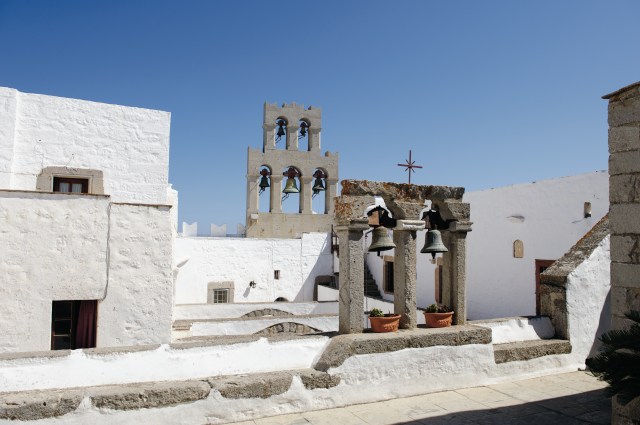 Massimiliano Cremascoli
Massimiliano CremascoliAnd here lies an opportunity. Beyond the shores of Patmos, in more ordinary places, Christians are invited to make room for silence. This task is more critical than ever before. And it is, among other things, an architectural challenge. It requires a renewed commitment to that peculiar thickness of which the Monastery of Saint John is such a vivid example.
Achieving such thickness demands effort across every domain, in projects large and small. Just as the term quietude spills over from the domain of sound into the domain of spirit, so here the word thickness must address both material and immaterial concerns.
The challenge, to be clear, is not easily addressed by adjusting consumer choices. There is no quick fix. And while the undertaking is costly, the problem will not be solved just by making more expensive purchases. A culture that has traded place for space and quietness for noise cannot simply buy its way out.
The challenge runs deeper. It is a question of meaning—of how and why, as a society, we build.
The task begins with a rediscovery of real materials—of which we can expect to know the sources and makers. It places a premium on qualities of integrity and simplicity: words with immaterial weight that apply nonetheless to material objects. And it calls for peculiar forms of expertise: the expertise of those who can read into the very outlines of the topography the hand of its creator, or recognize in the very grain of wood the veins of his mercy.
At a much larger scale, it may involve new patterns of sourcing, new supply chains, new delivery mechanisms, negotiations for the reopening of local quarries, conversations with the owners of nearby forests. It may require new ways of working; architects willing to scan a longer horizon; and builders willing to learn old habits, build thick walls, and pass on the skills needed for projects that do not aspire to fast-track completion. It may demand a resolve to wrestle with building codes and ordinances that are not drawn up with such ends in mind, and a readiness to forgo the financing mechanisms of the 15-month construction loan and 15-year mortgage. The work of the church will not be fully accomplished, after all, until the end of time.
It also involves rediscovering what it means to be placed by God in a particular location, honoring the features unique to that place and deepening investment in its people. That in turn demands a devotion to real, sustained relationship—investing for the long term in a future to which only the church of Christ can look with full confidence. This work must be pursued in community through time—building a culture of stewardship across generations, with grandparents who remember stories of God’s faithfulness and parents who commit to orienting their children’s children toward the voice of God.
But above all, it requires wrestling with questions that have been neglected by modernity. Only the church can hope to undo the relentless hollowing out of meaning in a culture that has lost sight of how architecture conveys theological truth, that fails to see the connection between material and immaterial, that has no concept of the thicker spiritual reality that shapes our thinly embodied existence.
This is a daunting task.
But it may yet contribute to building the church—not just the house of God, but the people of God—and to making places that draw those who recognize the value of silence when they hear it. It may yet build an architecture that attends to revelation, that welcomes others to cluster around and to build their homes and their lives in the shelter of God’s truth. And it may yet prove a blessing to those who hear, in anticipation of that day when to us, too, will be revealed the walls of the New Jerusalem, and we will stand within a place of absolute thickness, surrounded by a great multitude singing with full voice.
Kyle Dugdale is an architect, historian, and senior critic at Yale School of Architecture, where he teaches history, theory, and design. His latest book is titled Architecture After God.

